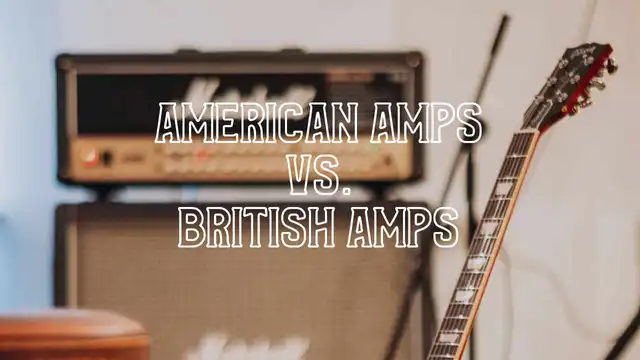American vs. British Tube Amps: What's the Difference?


In the guitar world, there’s lots of talk about American vs. British tube amps. Most tube amps tend to get grouped into one of those categories. Obviously those names refer to where the amps are made, but there’s more to it than just country of origin...
American and British amps also have their own distinct sound, which is why they’re separated like that. There’s also a lot of history that plays into that divide, but we’ll cover that later. For now, the focus is on what exactly are the American and British sound in reference to tube amps.
In this article, we’re going to clear all of that up. We’ll cover American and British amp companies/models, what their sound is, what makes them different, and who uses them.
The American Sound
First, let’s look at the American sound. We’ll get to specific amps in a bit, but for now, you can think of the American sound as Fender-style amps.
The main distinction between the American and British sound is in the mids. American amps typically emphasize the highs and lows, leaving a sort of scooped mid sound. British amps on the other hand focus more on highs and upper mids, giving them a sharper and tighter sound.
Because of this, American amps tend to sound “looser.” They aren’t as tight as British amps, but instead are a bit more boomy. The Fender Deluxe for example is known for having big and boomy lows.
Also, American amps are often described as having round and smooth low end. These amps tend to produce warm and deep lows that are clear and smooth.
As well as the focus on lows, American amps focus on highs too. These amps usually have a clear and cutting treble sound that pairs well with the emphasis on bass, providing a thick tone that has enough high-end to cut through a mix.
With the basics of the American sound covered, let’s move on to some examples of American amps and what makes them different from British amps.

Examples of American Amps
The classic American sound is essentially the Fender sound. There are other manufacturers though, such as Mesa, Kustom, ToneKing, Milkman, and more. But when people say/think American sound, it’s typically a Fender-ish amp that comes to mind.
Before getting too deep into things, it’s important to note that these are generalizations. Every amp sounds different. There are American amps that sound more British, and there are British amps that sound more American.
Ultimately, the amp’s country of origin doesn’t matter. It comes down to the amp’s construction, which is the main distinction between American and British amps.
The biggest difference between American and British amps is the tubes. American amps are usually fitted with 6L6s or 6V6s, while British amps get EL34 or EL84 tubes.
The 6L6 and 6V6 tubes used in American amps provide tons of clean headroom, meaning you really have to crank the amp to get it to compress. That’s why Fender amps are most known for their cleans; they provide crystal clear cleans at high volumes.
It’s easy to talk for hours about how American amps sound, but it’s a lot easier to just listen to some artists who used them. So let’s move onto some examples of players who used American amps.
American Amp Players
When it comes to the American sound, nothing defines it better than Fender. Their amps essentially are the American sound, even though there are other manufacturers with their own distinct sounds (like Mesa).
There are tons and tons of artists who used Fender amps, especially in the 60s and 70s. Most of the 60s California scene was using them—everyone from Jefferson Airplane to the Eagles. One great example is the Grateful Dead. Both Bob Weir and Jerry Garcia used Fender amps at the time, and their lush cleans and cutting leads are a great example of the American sound.
Another great example of the clean, American sound is the Beach Boys. Surf rock in general is built upon the American amp sound, and the Beach Boys are a perfect example of that. Their clean and pristine sound is emblematic of American amps, as well as that time of American music.
And to spice things up a bit with our last example, Neil Young is also an example of the American sound. Unlike the Dead and the Beach Boys though, Neil likes to crank his Fender up—a lot. However, his tones still have that iconic American “scooped mids” sort of sound.
The British Sound
Now, let’s talk about the British sound. As with the American sound, we’ll cover specific amps later. For now, think of British amps as Vox and Marshall style amps.
As explained earlier, the main difference between British and American amps is the mids. While American amps tend to have that scooped mid sound, British amps don’t. They put more of a focus on upper mids, giving their amps a sharper and more precise sounding tone.
British amps are also often described as being tighter. The low end is less boomy, and the focus is more on upper mids and highs. This makes the amp feel tighter and less loose than American style amps like Fenders.
These amps also tend to break up earlier. They don’t have as much headroom as American amps, so they begin to compress sooner. However, they also break up and compress differently, being softer and smoother than American amps.
If you’re looking for a tight, clear, and cutting tone that’s sharp with a focus on highs and upper mids, a British style amp is what you’re looking for.
Now, let’s look at some amps associated with the British sound.

Examples of British Amps
The two main amps that are associated with the British sound are Vox and Marshall. There are lots of other British amps, such as Hiwatt, Laney, Orange, and Blackstar. However, Vox and Marshall are the two most emblematic of the British sound, so we’ll focus on those.
As mentioned above, tubes are the big difference between American and British amps. American amps usually have 6L6s or 6V6s, while British amps are fitted with EL34 or EL84 tubes.
Sonically, this means that British amps have less headroom and compress earlier. They have a smoother yet sharper distortion that many players swear by. When it comes to British distortion, Marshall is the most common and well-known choice. However, that doesn’t mean the British sound is only defined by overdrive.
British amps have their own clean tones as well. Vox amps are typically used for cleans, and they’re known for their clear, sharp, and cutting cleans. Marshalls on the other hand are typically used for distorted tones.
That said, plenty of players have done the opposite with both. Vox amps for example are often used for distorted tones, and they retain their classic cutting and sharp tone when distorted as well.
Now, let’s look at some examples of artists using classic British amps.
British Amp Players
First, let’s look at a couple of Vox players. There is no one more associated with Vox than the Beatles. They used Vox amps on their first few records, and Vox amps are now forever associated with the Beatles. “All My Loving” from With the Beatles is a great example of the classic clean Vox sound.
Another good example of the Vox sound is U2. The Edge has used Vox amps for years, and they are a key part of the band’s sound. “Red Hill Mining Town” really showcases that classic Vox chime.
Now, let’s shift to Britain’s other defining amp company—Marshall. This is the other side of the British sound, and it’s just as iconic as the Vox sound.
Easily one of the most well-known examples of the Marshall sound is Jimmy Page. Few things are more iconic than Jimmy Page and a cranked Marshall. “The Song Remains The Same” from the live album The Song Remains The Same is a great example of this sound.
And to wrap things up with one final example, Clapton is also well-known for his use of a Marshall with Cream. His sound with Cream was incredibly influential at the time and has since become one of most iconic guitar tones ever. “Crossroads” from Cream is another perfect example of the Marshall sound.
American or British: Which Do You Choose?
The American vs. British amp debate has been going on for decades, and it probably won’t end anytime soon. The biggest difference between American and British amps is their mids; American amps focus on highs and lows with a scooped mid sound, while British amps focus on upper mids and highs. American amps also have higher headroom than British amps.
At the end of the day though, the choice is yours. Each amp style offers something different and unique. It ultimately depends on your tonal preferences and the tone you’re going for. We recommend trying them both out and seeing what you like the most. Just remember to string up with a fresh set of Stringjoys and have some fun!
Other Posts you may like

Guitar Strings Order: How the Guitar is Tuned and Why

Best Acoustic Guitar Strings for Beginners

Two Handed Tapping: Our Top 8 Tappers of All Time

Which Guitar Strings Wear Your Fret Wire Down More?

What is Nashville Tuning? Its History, Best Guitar Strings & Uses

Guitar Scale Length Explained: String Tension & Playability
0 Responses
Leave a Reply
Your email address will not be published. Required fields are marked *




